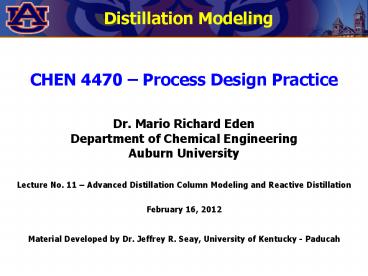CHEN 4470 – Process Design Practice PowerPoint PPT Presentation
Title: CHEN 4470 – Process Design Practice
1
Distillation Modeling
CHEN 4470 Process Design Practice Dr. Mario
Richard EdenDepartment of Chemical
EngineeringAuburn University Lecture No. 11
Advanced Distillation Column Modeling and
Reactive Distillation February 16,
2012 Material Developed by Dr. Jeffrey R. Seay,
University of Kentucky - Paducah
2
Distillation Fundamentals
- Understanding the Design Problem
- Distillation Column Design vs. Distillation
Column Rating - Requires different tools, i.e. DISTWU and RADFRAC
- Remember you must design the columns for 100
capacity, but rate them for 67 capacity - DISTWU
- This model uses the Winn-Underwood-Gilliland
method to estimate minimum reflux and number of
stages - RADFRAC
- Rigorous distillation rating model for a given
number of stages, feed location and reflux ratio
3
McCabe-Thiele Diagram
Column Design for a Binary System using
McCabe-Thiele Analysis
The graphical approach allows the engineer to
visualize how the design problem is bound. By
determining the minimum reflux ratio and the
minimum number of theoretical stages, we
determine the limits of the design problem. We
must complete the design process before beginning
the task of optimization! How can we determine
these values using Aspen Plus?
4
Distillation Column Design
Using DISTWU in ASPEN Plus
5
Distillation Column Rating
Using RADFRAC in ASPEN Plus
6
Tray Sizing and Rating
Using RADFRAC in ASPEN Plus
Tray Sizing Input Form
Tray Rating Input Form
7
Reactive Distillation
- Specifying Reactions and Chemistry
- Reactive distillation is often employed in
equilibrium systems to drive the reaction forward
by removing one of the components - In a Reactive Distillation column, each
theoretical stage can be considered as an
individual CSTR - From a kinetic standpoint, the design problem can
be equated to the CSTRs in Series problem from
your reactor design course - In ASPEN Plus REACTIONS and CHEMISTRY are NOT
the same thing!
A B ? C D
8
Reactive Distillation
- ASPEN Plus Input Forms
Defining the Reaction
RADFRAC Input Form
9
Reactive Distillation
- Balancing Kinetics and Hydraulics
The volume required for the CSTR is independent
of the column diameter required based on
hydraulics. Diameter in the column is typically
a function of vapor flowrate. In other words,
the tray hold-up requirement and the column
diameter requirement are mutually exclusive.
The variable that links these two requirements
in the height of the overflow weir.
Overflow Weir
Underflow Weir
Downcomer
10
Reactive Distillation
- Balancing Kinetics and Hydraulics (Contd)
Tray Hold-up Specification
11
Troubleshooting RADFRAC
- Common Problems
- Over specified column
- Not enough iterations
- Infeasible design specifications
- Operation below minimum reflux
- Wrong initialization routine
- Dont be afraid to use the Help Menu!
- If you get stuck, Bob Kline or I can help!

